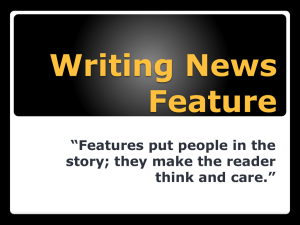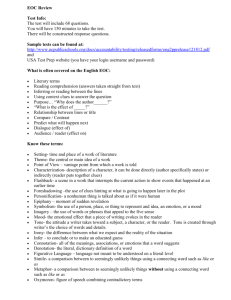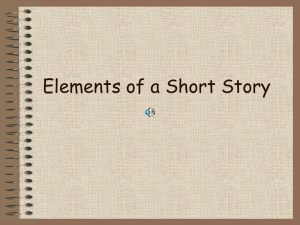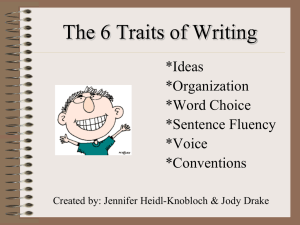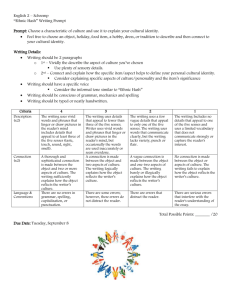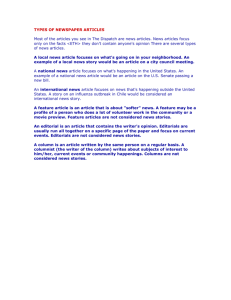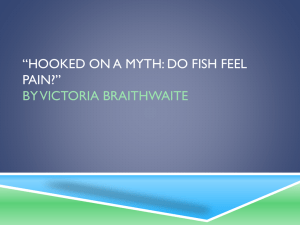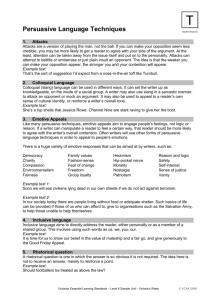Feature Story Types
advertisement
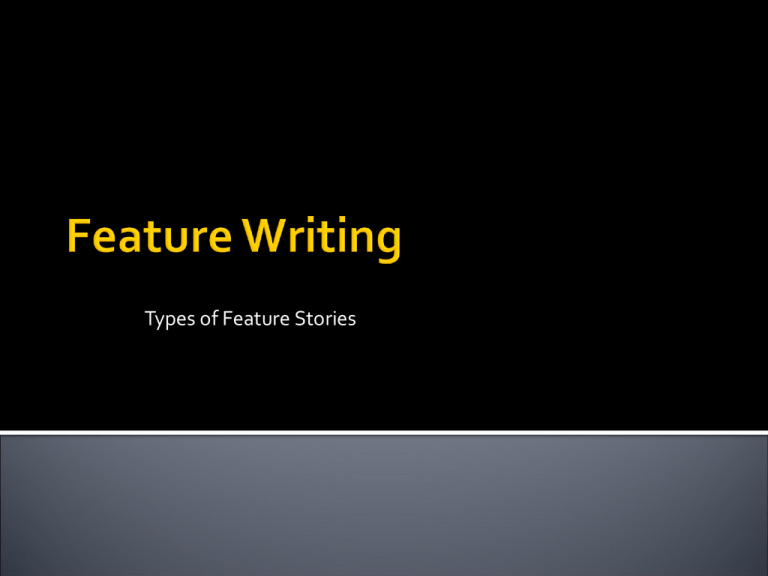
Types of Feature Stories One thing to remember is Feature stories, while journalistic, are first and foremost stories With a ▪ Beginning ▪ Introduction ▪ Middle ▪ Rising action, climax, falling action ▪ End ▪ Conclusion There are two genres of feature stories News Feature (Less common) ▪ Usually tied to a breaking story ▪ Has to be pushed out right away Timeless Story (More Common) ▪ No sense of urgency, often written over longer time ▪ Can be held until the right time to publish Categories and appeals There are at least 15 widely recognized types of features. All can be either news or timeless features Some categories are about “things” but people are more interesting Effective writers will transform the “Thing” feature into a “People” feature The commemorative story News features pegged to anniversary of an earlier news event Usually at the 1st anniversary and then in intervals ▪ 5, 10, 15, etc ▪ What are some examples of news events a commemorative feature can cover? Explanatory Story Shows the reader how something works Think of the show “Modern Marvels” ▪ How electricity or gas reach your home ▪ How chocolate, gum or cotton candy are made ▪ How bees make honey These types of features require much research ▪ You need to know almost as much as the experts you are interviewing in order to fill in the story The first person story Story written by the author about themselves Usually dramatic or personal ▪ Requiring the use of “I” throughout the story How I discovered… How I found out… When I… ▪ What type of events might be appropriate for this feature The Historical Story Usually pegged to a breaking news event When the news breaks it requires research for better understanding, leading to a feature ▪ Ex. Crews installing water line discover long buried street car tracks ▪ Construction of a new building is delayed while a pioneer cemetery is moved The Hobbyist story What are some of your hobbies? Most people collect something ▪ Any collectors in here? When selecting a story like this ▪ Make sure you are talking about the person ▪ With the biggest or most diverse collection ▪ With vast experience in the hobby The How-To Story Covers steps to do a task ▪ often a difficult, unfamiliar or uncommon task If the how-to is something that people charge for ▪ You may have to talk to several people before getting enough info for a feature The Invention Story A feature about people who have develop ▪ Unusual or helpful inventions ▪ How they came up with the ideas Or the inventions themselves ▪ Discussing details of how they work ▪ How they were put together The Medical Story Stories about illness (often costly ones) ▪ Chronicle the families financial plight ▪ In hopes of a donation ▪ Unusual illness ▪ Trying to find treatment ▪ Medical breakthrough stories ▪ Finding a cure ▪ Determining the cause of an illness The Number Story You develop a feature story about the top ▪ 10 restaurants ▪ 5 deadliest intersections ▪ 5 causes of stress The Odd-Occupation Story Think “Dirty Jobs” What are some odd jobs you can think of High rise window washers More on Pg 9 The Overview Story ▪ This is a feature that focuses on an issue/problem ▪ Includes statistics from official sources ▪ Gives reader an overview of the issue/problem ▪ Example- Feature story on domestic violence ▪ Start with a specific well known case Interview police, social workers, etc ▪ Include stats showing frequency of domestic violence Unknown to readers The Participatory Story Story where the writer immerses themselves in the story ▪ Feature on a sanitation worker ▪ Writer works as a sanitation worker for a few days ▪ Well known story ▪ Nelly Bly writer for the New York World Had herself committed to an insane asylum To write about the conditions there The Profile Story Story done on someone of interest ▪ Arrange interview ▪ Do some research on the person ▪ Interview subject and others who know them ▪ If people are uncooperative You will rely on others only and research ▪ Should paint a word portrait of the person ▪ Reader should get a sense of how the person Looks, sounds and thinks The Unfamiliar Visitor Story Story where the perspective of the topic I given by a visitor For example ▪ Your town has a high unemployment rate ▪ A visiting diplomat from China is in town ▪ You write about their perspective ▪ Show how is unemployment handled in China

